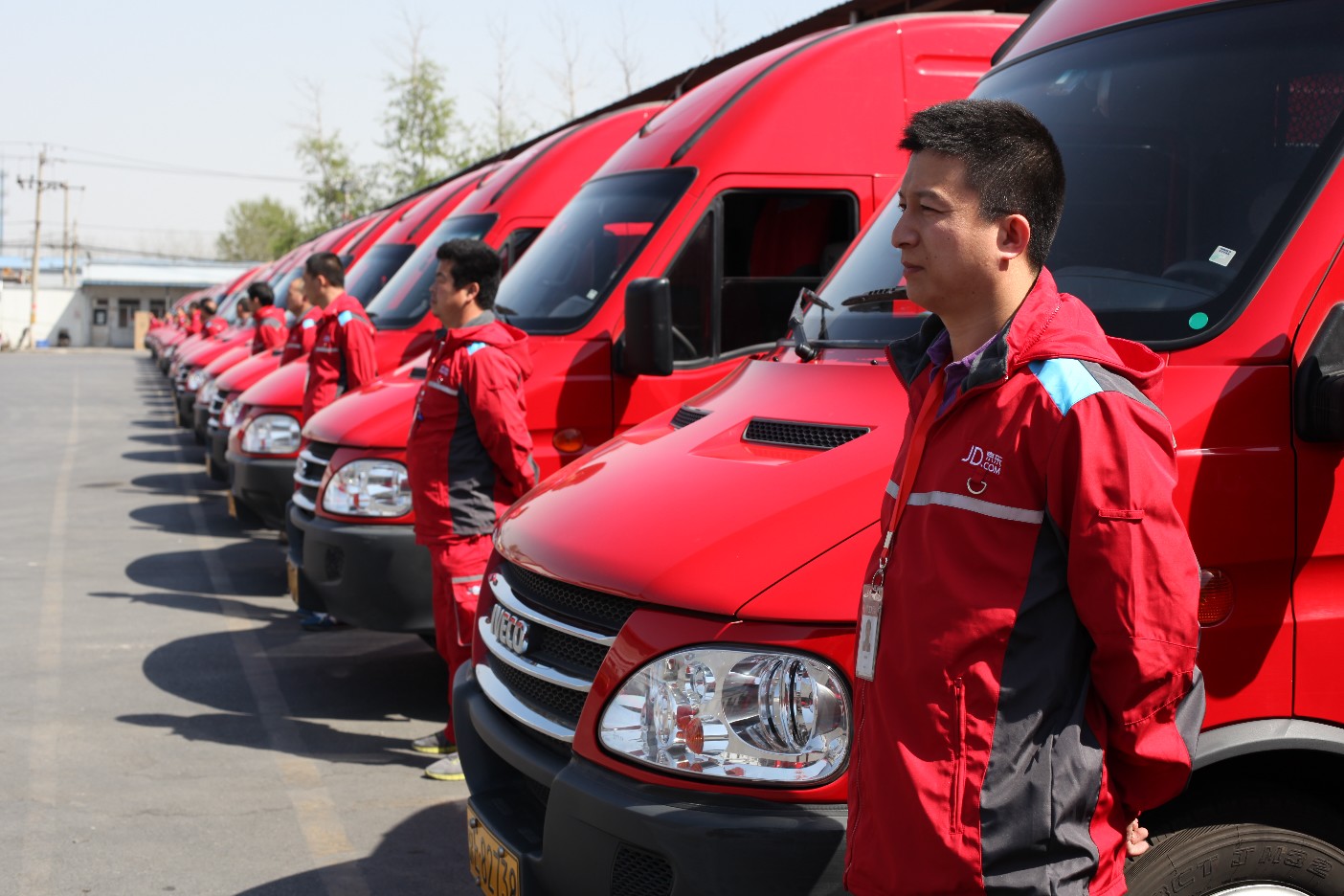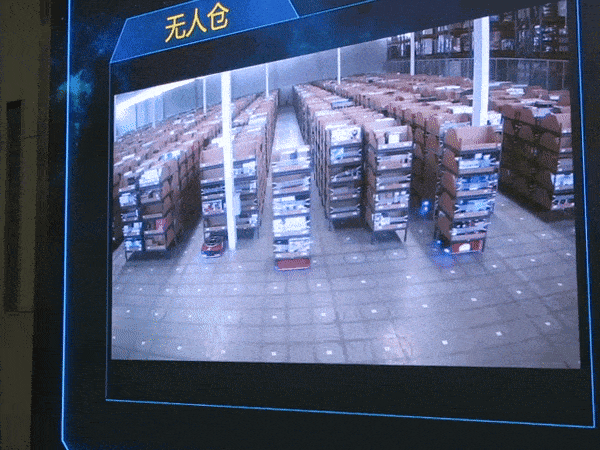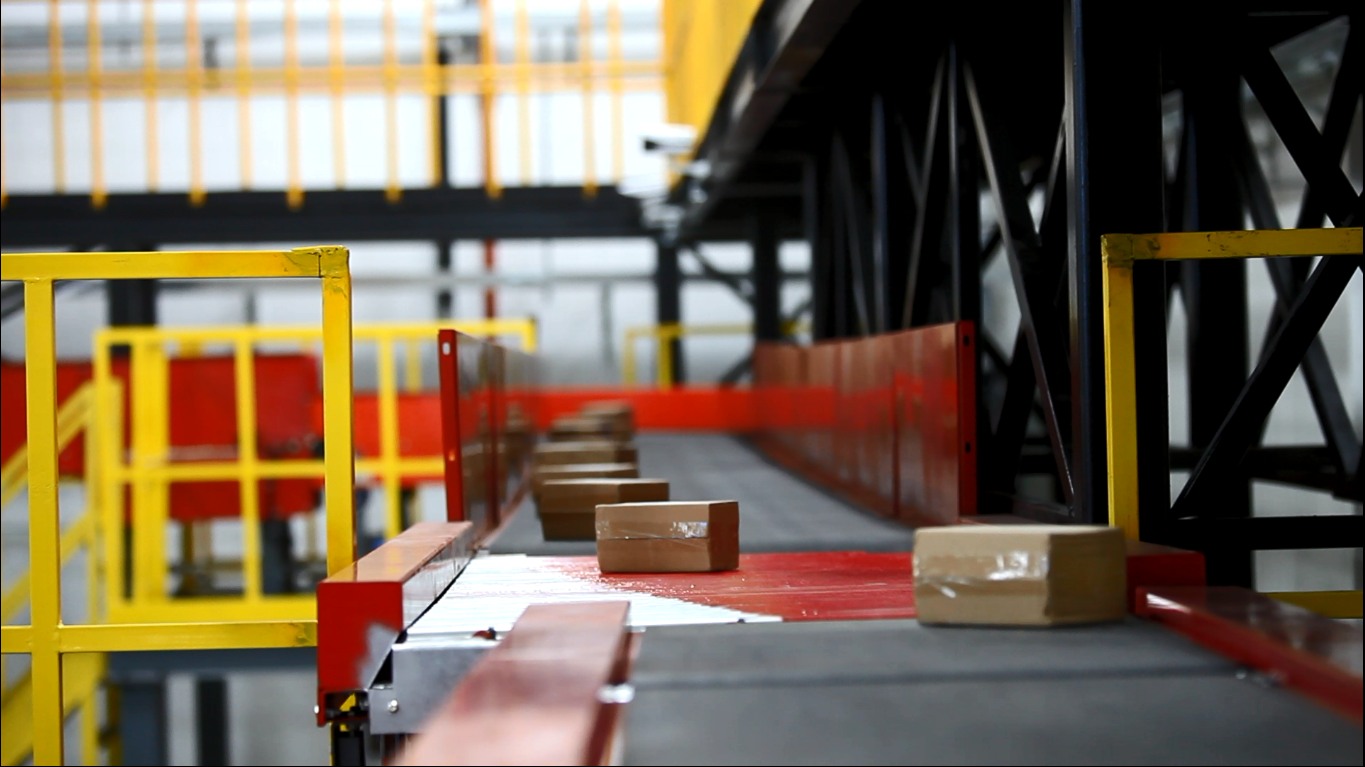
Chinese ecommerce giant JD relies on around 65,000 employees for its last mile delivery service. Photo credit: JD.
Inside a warehouse in the southeast corner of Beijing, a crane-like robot patiently picks up packages from pallet to container. Red banners are strewn across the top of the wall, inscribed with slogans like “Innovation never rests” and “We advance towards smart logistics.”
This is JD-X, the logistics lab of Alibaba’s ecommerce archival JD. Launched last May, the R&D unit has teams in China and Silicon Valley, and develops a wide range of applications and tech: anything related to the movement and processing of packages – autonomous drones, delivery robots, and unmanned warehouses.
Right now, it’s very hard to recruit workers to work in the warehouse and for last-mile delivery.
“Our goal is to develop ‘dark warehouses,’” Huang Fengquan, head of planning for JD Automated Warehousing Solutions, told media during a tour of the lab’s facilities on Monday. Like ‘dark factories,’ dark warehouses refer to completely autonomous facilities where robots work alone in the dark, completing tasks formerly done by humans.
Automating the logistics sector is a global trend, but in China, the stakes are especially high as the country’s population rapidly ages and labor costs rise. In particular, the one-child policy has whittled down the number of available young workers. According to China’s National Bureau of Statistics, the number of workers between 16 and 59 years old plunged by almost 5 million in 2015. As the labor pool shrinks, demands for better benefits and higher wages have also risen.
“Right now, it’s very hard to recruit workers to work in the warehouse and for last-mile delivery,” explained Beth Bao, director of strategy at JD Logistics. That’s actually a more crucial factor than cost at the moment, she said.
“The wages are going up [like] in the United States,” she continued. “I’ve talked to a lot of partners in the US, they also see the labor shortage. It’s very hard for them to get workers to work in those environments.”
Logistics as a service
Globally, growth in the ecommerce industry has also galvanized companies to automate fulfillment centers. In 2012, Amazon paid US$775 million to acquire Kiva Systems, whose Roomba-like robots can carry inventory shelves across warehouse floors. In October, JD announced its first dark warehouse in Shanghai – a massive 16,000 square meter facility that has the area size of around three football fields.

A live stream of Kiva-like robots moving inventory shelves in JD’s unmanned Shanghai warehouse. Image credit: Tech in Asia.
Warehouse automation could also optimize workflows and boost efficiency – a top priority for China, whose costs from the logistics sector amounted to 15 percent of its GDP last year. It’s a huge market, said Bao, explaining that JD Logistics – a newly minted business group under JD – aims to be a one-stop shop supply chain provider that serves businesses outside of the ecommerce industry.
“We’re providing the whole supply chain service to brands, which means from warehousing to transportation, to last-mile delivery,” she said. “We can also provide predictive analytics for the brands because we own the customer information. We know where they are and what they like.”
On the data analytics side, JD competes with Alibaba, whose logistics arm Cainiao provides merchants with online and offline inventory management. Cainiao, however, works with third-party delivery companies, whereas most of JD’s couriers are full-time employees. To deal with peak periods, such as the upcoming Singles Day shopping bonanza, JD has also taken on temporary couriers as part of its merger with Dada, a crowdsourced delivery network.
Once its logistics technology matures, such as its package-picking robots, JD can offer that as a service to clients as well, Bao said.
See: What you need to know about China’s largest shopping holiday

JD’s automated sorting center in Kunshan. Photo credit: JD.
Robot vs Man
However, developing smarter warehouses won’t be cheap. In fact, increasing automation in fulfillment centers may not result in immediate cost benefits in the short term, especially since automation is still limited to certain tasks and products. For instance, JD’s Shanghai warehouse only handles certain electronics like smartphones, a more standardized vertical than something like apparel.
And while labor costs may be rising, human workers are still relatively cheap and sometimes more cost-effective, especially in developing countries like India.
“In the US, the labor cost is very high – US$15 to 18 per hour – but the capital costs are low, because the interest rates are also very low. In India, the capital costs are high, the labor cost or the variable cost is relatively lower,”Amazon India VP Akhil Saxena told Tech in Asia during a tour of the company’s largest fulfillment center in India.
He added, “So, the arbitrage is to say at what tipping point or at what ratio between automation and manual does it make sense to build a very large building and put a lot of Kiva robots here.”
See: No robots, please, we’re Indian – the lowdown on Amazon’s localization strategy
Variety in product size is also a constraint. Heavier goods such as refrigerators require heftier robots that are often slower than their more petite counterparts. Delta, JD’s claw-like robot, is capable of picking up 2,500 to 3,000 products per hour, and can only handle objects that weigh between 50 grams and 3 kilograms. The company’s larger 6-axis robot, which can handle 100 to 160 kilogram items, takes 10 to 12 seconds to move one item.
This is why warehouses may have to be classified by product size, explained Huang in JD-X’s test warehouse facility. “It’s more complicated when orders are mixed,” he said. JD Logistics’ inventory management system has to separate orders into different warehouses before collecting them for delivery.

The JDRover, a last-mile delivery robot. Currently being tested on four university campuses, the JDRover still needs some kinks worked out – the bot ran into the curb shortly after this photo was taken. Photo credit: Tech in Asia.
Still, it’s clear that automation at some level is the future. According to Huang, the company’s smaller Delta robot is 10 times more efficient at picking packages than current warehouse workers.
“Even though [logistics automation technology] will increase costs at the moment, using robots to replace human workers makes financial sense in the long term,” Li Hao, an analyst at iResearch, told Tech in Asia. One day, robots will be able to completely replace human laborers, but it might take more than 10 years because of the investment required for R&D, she said.
Addressing concerns that humans will be replaced with robots, JD is adamant that its investment in smart logistics won’t affect existing employees. The unmanned warehouse in Shanghai, for instance, is a new facility – not an upgrade of an existing one, said a company spokesperson.
Workers whose jobs are reassigned to robots will also have the opportunity to transfer within the company, explained Li Yuqian, an algorithm engineer on JD-X’s autonomous delivery robot team. Because the majority of JD’s logistics workforce are couriers and not warehouse workers, they would be the most affected by autonomous delivery vans and last-mile delivery robots. However, it’s unclear how easy it will be for blue-collar workers like delivery men to pivot into new careers.
“I think [delivery robots] will replace delivery jobs, but not the delivery guys,” she emphasized. “They are still the employees of JD, because they will work on maintenance or other important jobs.”
This post China’s ecommerce turns to robots as labor shortage looms appeared first on Tech in Asia.
from Tech in Asia https://www.techinasia.com/jd-x-logistics-unmanned-warehouses
via IFTTT
No comments:
Post a Comment